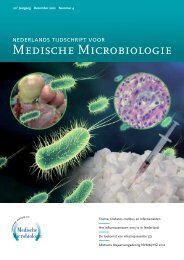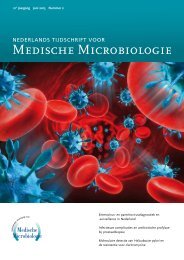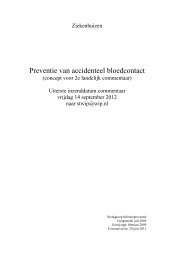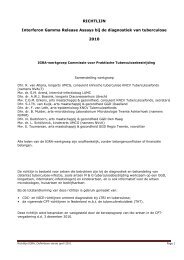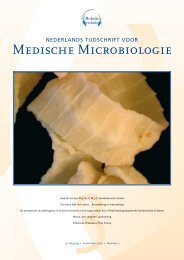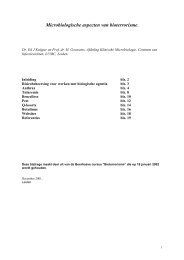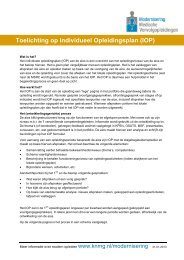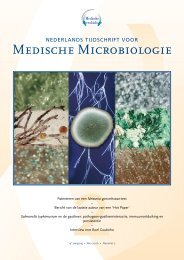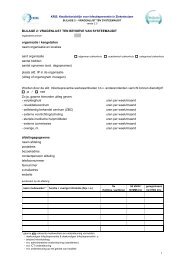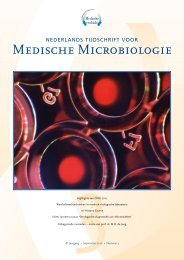Supplement bij veertiende jaargang, april 2006 - NVMM
Supplement bij veertiende jaargang, april 2006 - NVMM
Supplement bij veertiende jaargang, april 2006 - NVMM
Create successful ePaper yourself
Turn your PDF publications into a flip-book with our unique Google optimized e-Paper software.
75 mgr/liter aztreonam and 5 mg/liter ceftizoxim and<br />
incubated for > 15 hours at 370°C. DNA was extracted<br />
(Magna-Pure Roche) from both the saline and the broth and<br />
subjected to a real-time multiplex PCR assay based on the<br />
Huletsky protocol (Québec, Canada). DNA extracted from<br />
the broth was also subjected to the MRSA-test from HAIN<br />
(Germany). Two swabs obtained from two patients with a<br />
MRSA infected wound were included as positive controls.<br />
PCR positive samples were subjected to extensive culture<br />
procedures.<br />
Results: The 2 MRSA-positive swabs were positive in<br />
all tests. None of the 152 swabs were MRSA-positive on<br />
standard culture. However, the Huletski-PCR showed that<br />
4/152 saline samples and 25/152 broth samples were clearly<br />
MRSA-positive (Ct values < 40). By using the HAIN-test<br />
on the broth samples, 7/152 samples proved to be MRSApositive,<br />
these 7 samples were also positive in the Huletsky-<br />
PCR. After extensive culturing from 17/25 Huletsky-PCR<br />
positive samples a MRSA-strain could be recovered.<br />
Conclusions: Molecular detection provides a very powerful<br />
method for the detection of MRSA, especially when a preenrichment<br />
broth is part of the procedure. Disturbing<br />
however is the high MRSA prevalence when using these<br />
strategies. Based on these result, the MRSA prevalence in<br />
our region is between 5 and 15%, so at least 10 times higher<br />
than expected.<br />
05.09<br />
novel variants of Staphylococcus Cassette Chromosomes<br />
excised by ccrA/B type 2 recombinases in Staphylococcus<br />
aureus<br />
W.T.M. Jansen, M.M. Beitsma, C.J. Koeman, W.J.B. Wamel,<br />
J. Verhoef, A.C. Fluit<br />
UMCU, Medical Microbiology, Utrecht<br />
Background: Staphylococcal Cassette Chromosome mec<br />
(SCCmec) type IV is associated with virulent communityacquired<br />
MRSA and frequent horizontal transfer among<br />
Staphylococci. To gain insight into the mechanism of<br />
transfer, we studied the by ccrA/B type 2 recombinase<br />
mediated excision of SCCmec II and IV.<br />
Methods: A ccrA/B type 2 plasmid was constructed, in<br />
which the ccrA/B genes were placed under control of a<br />
constitutive phage-repressor promoter. The plasmid was<br />
transduced into different MRSA strains, including MR108,<br />
MW2, Ca05 (JCSC1968), JCSC1978, Mu50 and N315, and<br />
a set of strains that demonstrated the in vivo transfer of<br />
SCCmec IV (MSSA wkz1, MRSA wkz2, and Staphylococcus<br />
epidermidis O7.1 (Wielders et al. Lancet 2001:357:1674).<br />
Excision of SCC elements was determined by PCR and<br />
sequencing.<br />
Results: In wild-type MRSA and S. epidermidis strains<br />
containing SCCmec IV, but not in SCCmec II MRSA<br />
Ned Tijdschr Med Microbiol <strong>2006</strong>; 4:<strong>Supplement</strong><br />
S25<br />
strains, excision of the cassette was observed. Introduction<br />
of the ccrA/B type 2 plasmid in the different strains<br />
yielded excision of SCCmec II and multiple excision<br />
variants of SCCmec IV. Sequencing of the alternatively<br />
excised products in several SCCmec IV wild-type strains<br />
and clones identified a 100 bp shortened SCCmec variant<br />
and novel excision products in MRSA wkz2 not present<br />
in SCCmec donor O7.1. Sequencing showed a 5,877<br />
bp, conserved SCC-like element that lacks mecA and<br />
ccrA/B recombinases, which was also present in MR108.<br />
Excision of the SCC-like element in wild type S. aureus<br />
was dependent on the presence of SCCmec. The element<br />
could be excised separately or as part of a novel composite<br />
cassette together with SCCmec.<br />
Conclusions: Four SCC excision variants were identified<br />
in SCCmec IV strains, including the in vivo formation of a<br />
new composite SCCmec cassette with a SCC-like element.<br />
SCCmec II was only excised in the presence of the ccrA/B<br />
2 plasmid. The variety in SCC excisions may increase<br />
horizontal transfer and genetic plasticity in SCCmec IV<br />
MRSA strains.<br />
05.10<br />
A specific secretion system mediates PPe protein transport<br />
in Mycobacteria and is required for virulence<br />
W. Bitter1 , A.M. Hannes1 , C.M.J.E. Vandenbroucke-Grauls 1 ,<br />
T. Verboom1 , B.J. Appelmelk1 , J. Luirink3 , R. Musters2 ,<br />
F. Abdallah1 1 2 VU medical centre, Medical Microbiology, Amsterdam, VU<br />
medical centre, Physiology, 3VU medical centre, Molecular<br />
Microbiology, Amsterdam<br />
The Mycobacterium tuberculosis genome contains two<br />
large gene families, the so-called PE and PPE genes, that<br />
are unique to mycobacteria. Here we report that one of<br />
the PPE proteins, i.e. PPE41, is secreted both in vitro and<br />
in macrophages. Furthermore, we have identified that<br />
PPE41 is secreted by a novel secretion system, which is<br />
homologous to the mycobacterial ESAT-6 secretion system.<br />
This secretion system, designated ESX-5, is conserved in<br />
pathogenic mycobacteria, but is not present in the environmental<br />
species Mycobacterium smegmatis. However, introduction<br />
of the entire ESX-5 region in M. smegmatis resulted<br />
in efficient secretion of heterologously expressed PPE41,<br />
which shows that ESX-5 is necessary and sufficient for<br />
PPE transport. ESX-5 secretion mutants showed reduced<br />
spreading of mycobacteria to uninfected macrophages,<br />
which shows that ESX-5 secreted substrates play an<br />
important role in virulence.




